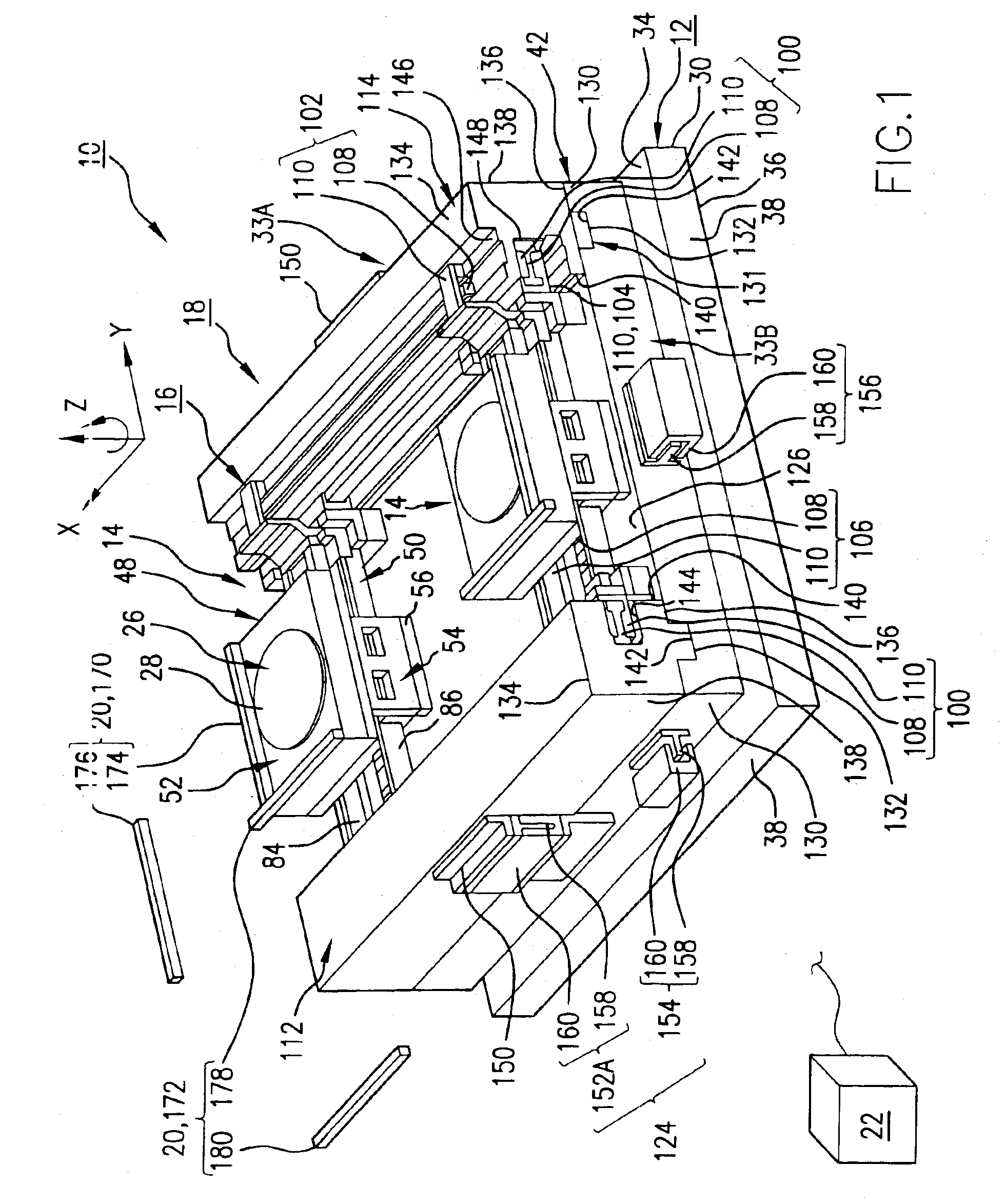System and method for resetting a reaction mass assembly of a stage assembly
- Summary
- Abstract
- Description
- Claims
- Application Information
AI Technical Summary
Benefits of technology
Problems solved by technology
Method used
Image
Examples
second embodiment
[0180]FIGS. 8-10 illustrate a second embodiment having features of the present invention. In particular, FIG. 8 illustrates a perspective view of the stage assembly 10, FIG. 9 illustrates a top plan view of the stage assembly 10 of FIG. 8, and FIG. 10 illustrates an exploded perspective view of the reaction mass assembly 18. The stage assembly 10 illustrated in FIGS. 8 and 9 includes the stage base 12, a pair of stages 14, the stage mover assembly 16, the reaction mass assembly 18, the measurement system 20, and the control system 22.
[0181]In the embodiment illustrated in FIGS. 8-9, each stage 14, the stage mover assembly 16, the measurement system 20, and the control system 22 are somewhat similar to the equivalent components described above. However, in the embodiment illustrated in FIGS. 8-10, the stage base 12 and the reaction mass assembly 18 differ from the embodiment illustrated in FIGS. 1-3.
[0182]In the embodiment illustrated in FIGS. 8-10, the X reaction component 33A inclu...
third embodiment
[0200]FIGS. 11-13 illustrate a third embodiment having features of the present invention. In particular, FIG. 11 illustrates a perspective view of the stage assembly 10, FIG. 12 illustrates a perspective view of the reaction mass assembly 18, and FIG. 13 illustrates an exploded perspective view of the reaction mass assembly 18. The stage assembly 10 illustrated in FIG. 11 includes the stage base 12, a pair of stages 14, the stage mover assembly 16, the reaction mass assembly 18, and the control system 22. The measurement system is not illustrated in FIG. 11.
[0201]In the embodiment illustrated in FIG. 11, each stage 14, the stage mover assembly 16, and the control system 22 are somewhat similar to the equivalent components described above. However, in the embodiment illustrated in FIGS. 11-13, the stage base 12 and the reaction mass assembly 18 differ from the embodiment illustrated in FIGS. 1-3 and the embodiment illustrated in FIGS. 8-10.
[0202]In the embodiment illustrated in FIGS....
fourth embodiment
[0221]FIGS. 14-16 illustrate a fourth embodiment having features of the present invention. In particular, FIG. 14 illustrates a perspective view of the stage assembly 10, FIG. 15 illustrates a perspective view of the reaction mass assembly 18, and FIG. 16 illustrates an exploded perspective view of the reaction mass assembly 18. The stage assembly 10 illustrated in FIG. 14 includes the stage base 12, a pair of stages 14, the stage mover assembly 16, the reaction mass assembly 18, and the control system 22. The measurement system is not illustrated in FIG. 14.
[0222]In the embodiment illustrated in FIG. 14, each stage 14, the stage mover assembly 16, and the control system 22 are somewhat similar to the equivalent components described above. Further, the stage base 12 and the reaction mass assembly 18 illustrated in FIGS. 14-16 are similar to the stage base 12 and reaction mass assembly 18 illustrated in FIGS. 11-13 and described above. However, in the embodiment illustrated in FIGS. ...
PUM
 Login to View More
Login to View More Abstract
Description
Claims
Application Information
 Login to View More
Login to View More - R&D
- Intellectual Property
- Life Sciences
- Materials
- Tech Scout
- Unparalleled Data Quality
- Higher Quality Content
- 60% Fewer Hallucinations
Browse by: Latest US Patents, China's latest patents, Technical Efficacy Thesaurus, Application Domain, Technology Topic, Popular Technical Reports.
© 2025 PatSnap. All rights reserved.Legal|Privacy policy|Modern Slavery Act Transparency Statement|Sitemap|About US| Contact US: help@patsnap.com



